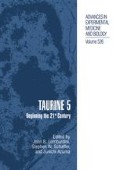Abstract
Parenteral injection of kainic acid (KA), a glutamate receptor agonist, causes severe and stereotyped behavioral convulsions in mice and is used as a rodent model for human temporal lobe epilepsy. The goal of this study is to examine the potential anti-convulsive effects of the neuro-active amino acid taurine, in the mouse model of KA-induced limbic seizures.
We found that taurine (43 mg/Kg, s.c.) had a significant antiepileptic effect when injected 10 min prior to KA. Acute injection of taurine increased the onset latency and reduced the occurrence of tonic seizures. Taurine also reduced the duration of tonic-clonic convulsions and mortality rate following KA-induced seizures. Furthermore, taurine significantly reduced neuronal cell death in the CA3 region of the hippocampus, the most susceptible region to KA in the limbic system.
On the other hand, supplementation of taurine in drinking water (0.05%) for 4 continuous weeks failed to decrease the number or latency of partial or tonic-clonic seizures. To the contrary, we found that taurine-fed mice showed increased susceptibility to KA-induced seizures, as demonstrated by a decreased latency for clonic seizures, an increased incidence and duration of tonic-clonic seizures, increased neuronal death in the CA3 region of the hippocampus and a higher post-seizure mortality of the animals.
We suggest that the reduced susceptibility to KA-induced seizures in taurine-injected mice is due to an increase in GABA receptor function in the brain which increases the inhibitory drive within the limbic system. This is supported by our in vitro data obtained in primary neuronal cultures showing that taurine acts as a low affinity agonist for GABAA receptors, protects neurons against kainate excitotoxic insults and modulates calcium homeostasis. Therefore, taurine is potentially capable of treating seizure-associated brain damage.
Access this chapter
Tax calculation will be finalised at checkout
Purchases are for personal use only
Preview
Unable to display preview. Download preview PDF.
References
Ben-Ari, Y., 1985, Limbic seizure and brain damage produced by kainic acid: mechanisms and relevance to human temporal lobe epilepsy. Neuroscience, 14:375–403.
Ben-Ari, Y., 2002, Excitatory actions of GABA during development: the nature of the nurture. Nature Neurosci.,3:728–739.
Bruton, C.J., 1993, ‘Status epilepticus. I: Pathogenesis’. Dey. Med. Child. Neurol., 35:277–282.
del O1mo, N., Bustamante, J., del Rio, R.M., and Solis, J.M., 2000, Taurine activates GABA(A) but not GABA(B) receptors in rat hippocampal CAI area. Brain Res., 864:298–307.
El Idrissi, A., and Trenkner, E., 1999, Growth factors and taurine protect against excitotoxicity by stabilizing calcium homeostasis and energy metabolism. J. Neurosci., 19:9459–9468.
Eppler, B., Patterson, T.A., Zhou, W., Millard, W.J., and Dawson, R. Jr., 1999, Kainic acid (KA)-induced seizures in Sprague-Dawley rats and the effect of dietary taurine (TAU) supplementation or deficiency. Amino Acids. 16:133–147.
Gregory, L., Ben-Ari, H., and Ben-Ari, Y., 1998, Seizures in the Developing Brain: Perhaps Not So Benign after All. Neuron, 21,1231–1234.
Kuriyama, K., and Hashimoto, T., 1998, Interrelationship between taurine and GABA. Adv. Exp. Med. Biol., 442:329–337.
Mellor, J.R., Gunthorpe, M.J., and Randall, A.D., 2000, The taurine uptake inhibitor guanidinoethyl sulphonate is an agonist at gamma-aminobutyric acid(A) receptors in cultured murine cerebellar granule cells. Neurosci. Leu., 286:25–28.
O’Byrne, M.B., and Tipton, K.F., 2000, Taurine-induced attenuation of MPP+ neurotoxicity in vitro: a possible role for the GABA(A) subclass of GABA receptors. J. Neurochem., 74:2087–2093.
Quinn, M.R., and Harris, C.L., 1995, Tautine allosterically inhibits binding of [35S]-tbutylbicyclophosphorothionate (TBPS) to rat brain synaptic membranes. Neuropharmacology, 34:1607–1613.
Trenkner, E., 1991, Cerebellar cells in culture. In Culturing Nerve Cells (G. Banker and K. Goslin, eds.), MIT Press, pp. 283–307.
Wang, D.S., Xu, T.L., Pang, Z.P., Li, J.S., and Akaike, N., 1998, Taurine-activated chloride currents in the rat sacral dorsal commissural neurons. Brain Res., 792:41–47.
Author information
Authors and Affiliations
Editor information
Editors and Affiliations
Rights and permissions
Copyright information
© 2003 Springer Science+Business Media New York
About this chapter
Cite this chapter
El Idrissi, A., Messing, J., Scalia, J., Trenkner, E. (2003). Prevention of Epileptic Seizures by Taurine. In: Lombardini, J.B., Schaffer, S.W., Azuma, J. (eds) Taurine 5. Advances in Experimental Medicine and Biology, vol 526. Springer, Boston, MA. https://doi.org/10.1007/978-1-4615-0077-3_62
Download citation
DOI: https://doi.org/10.1007/978-1-4615-0077-3_62
Publisher Name: Springer, Boston, MA
Print ISBN: 978-1-4613-4913-6
Online ISBN: 978-1-4615-0077-3
eBook Packages: Springer Book Archive

